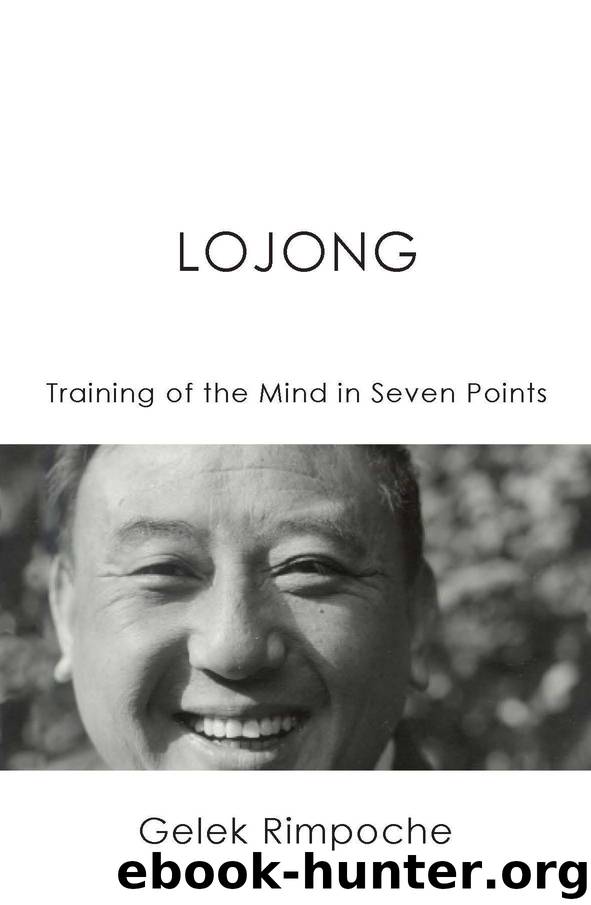Lojong Mind Training in Seven Ponits by Rimpoche Gelek

Author:Rimpoche, Gelek [Rimpoche, Gelek]
Language: eng
Format: epub
Publisher: Jewel Heart Corp
Published: 2013-06-20T16:00:00+00:00
Taking also, we have done with three points: first taking the suffering, second taking the cause of suffering, and among the cause of suffering, the major focus is on the delusions; third is taking the imprints of the delusions.
The three different ways of giving and of taking you mount on the breath.
I recommended to you, to combine them together with the verse [61] from the Lama Chöpa. When you say the verse three times, you practice the three different givings, three different takings.
I hope those of you who are practicing all of that, you do have some idea now. This is the first layer of tonglen, not the second etc. Actually, it goes up to the tenth, but the tenth is relevant only at the Buddha level, not here. These are the major points of tonglen. Read Pabongka’s Liberation in the Palm of your hand , day 17, 18 and 19, and also read the Sogyal Rimpoche’s Tibetan book of living and dying , Ch. xii 14 . P ick up any good information that you can get on it. Read. But that doesn’t mean every book that you read is absolutely true and correct and reality. Read many and draw your own conclusions. Informations are for you to collect, to make your mind up. And the decisions you make, by yourself, for your own good, using the best information available. And when you can’t make a decision, talk to others. That’s why you have groups. And group leaders should take care that there is a free information flow. They should not make it very rigid, very square. I believe the difference between the openness and the cult system is based on this. In the sixties we fought for free information, in the nineties we must preserve that. Openness is important, let the information flow free.
B. Practice in between the meditation sessions
There are three objects, three poisons, and three roots
of virtue.
The three objects are friend, enemy and neutral people. You’re focusing on the people, and when you look at them, some you like, some you hate, and some you don’t care for. That is what the three objects are, and because of those three objects, you get three poisons – attachment, hatred and ignorance. The three virtues are being free of those three poisons, so: attachment-free good work, hatred-free good work, ignorance-free good work.
What do they tell you here? If the virtue is not attachment-free it is considered to be not that correct. Likewise virtue that is not hatred-free. It is hard to get ignorance-free, but try to get at least attachment- and hatred-free. In other words, be free of the expression ‘what’s in it for me?’
When you’re raising any one of these three poisons, you should think, ‘Ha! I’m getting this attachment. This attachment is rising with me. Okay, it’s not good for me, fine. Having this attachment rise in me, I hope will substitute these people’s like, dislike, and couldn’t care less, which, in fact, all are attachment.
Download
This site does not store any files on its server. We only index and link to content provided by other sites. Please contact the content providers to delete copyright contents if any and email us, we'll remove relevant links or contents immediately.
| Anthropology | Archaeology |
| Philosophy | Politics & Government |
| Social Sciences | Sociology |
| Women's Studies |
Welcoming the Unwelcome by Pema Chodron(618)
Bardo or Not Bardo by Antoine Volodine(546)
Dzogchen by The Dalai Lama(529)
Taming the Tiger Within by Thich Nhat Hanh & Pritam Singh(485)
A Step Away from Paradise: The True Story of a Tibetan Lama's Journey to a Land of Immortality by Shor Thomas(481)
The Six Perfections by Lama Zopa Rinpoche(472)
The Tibetan Book of the Dead by Dorje Gyurme & Coleman Graham(466)
0307731871 (N) by Elizabeth Esther(463)
Awaken Every Day by Thubten Chodron(455)
A Guided Tour of Hell by Samuel Bercholz(443)
The Compassion Book by Pema Chodron(440)
A Death on Diamond Mountain: A True Story of Obsession, Madness, and the Path to Enlightenment by Scott Carney(417)
A Direct Path to the Buddha Within by Klaus-Dieter Mathes(411)
Pointing Out the Great Way: The Stages of Meditation in the Mahamudra Tradition by Brown Ph.D. Daniel & Robert Thurman(405)
The Psychedelic Experience by Leary-Alpert-Metzner(379)
The Heart of Unconditional Love by Tulku Thondup(360)
Wisdom Energy: Basic Buddhist Teachings by Jonathan Landaw & Lama Yeshe & Lama Zopa Rinpoche(353)
Buddhist Magic by Sam Van Schaik(350)
Magic and Mystery in Tibet by Alexandra David-Neel(348)
